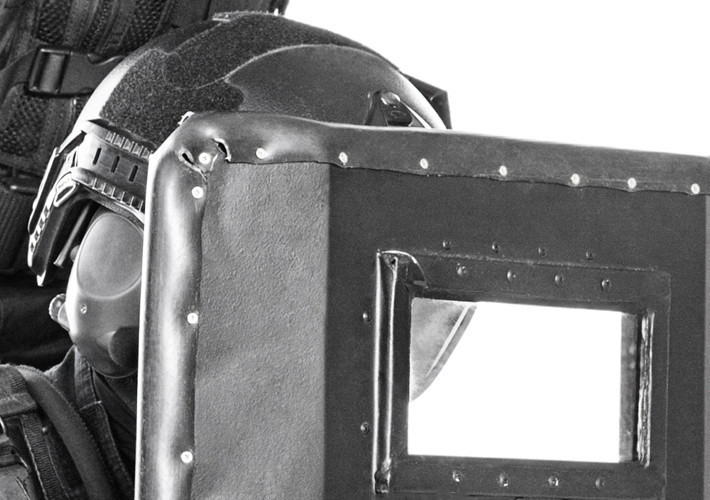
ASTM International has released two new standards for the ballistic shields used by law enforcement officers.
By Casandra Robinson
Nov 11, 2022
The unfortunate reality of the law enforcement profession is that officers are routinely placed in harm’s way. For this reason, officer safety is a top priority.
One way that officers mitigate the risk of duty-related injuries or death is by using protective equipment, such as ballistic shields. ASTM International has released a pair of standards designed to assess the performance of ballistic shields and their ability to stop bullets.
Traditionally, the use of ballistic shields was limited to tactical team operations. With the increase in incidents requiring immediate intervention, agencies have recognized the need to protect all officers, from the tactical operator to the routine patrol officer. In an incident where an armed suspect is actively attempting to harm innocent victims, ballistic shields have been critical in providing the first officers on-scene with necessary protection.
ASTM’s standard specification for ballistic-resistant shields used by law enforcement officers (E3347) specifies the minimum performance requirements and test methods for the ballistic resistance of shields used by U.S. law enforcement officers to protect against handgun and rifle ammunition.
READ MORE: Big Data and Robotics/A-UGVs
Patricia Knudson is an officer with the Phoenix AZ Police Department Tactical Support Bureau and the vice chair of the subcommittee on public safety equipment (E54.04), part of the committee on homeland security applications (E54). “Having gone through the unfortunate experience of being an officer who was shot in the line of duty, I understand, probably better than most, the importance of ballistic protection,” Knudson says. “Ballistic protection is not an option in the world of law enforcement; it is a necessity.”
“To use a ballistic shield, the officer needs to know it will perform as expected,” Knudson continues. “If a ballistic shield is designed to protect an officer from a certain ballistic threat, then that is what it should do. The officer’s life most likely depends on that protection. Having a ballistic shield specifically tested to an acceptable standard and held to a level of accountability is critical for the officer to have the unquestionable confidence to deploy with that ballistic shield during a potentially life-threatening situation.”
Ballistic-resistant shields used by law enforcement officers are complex protective technologies that consist of the main shield body’s ballistic-resistant materials, a transparent ballistic-resistant viewport, fasteners, joints and seams, edging, appliques (intended to increase localized protection), and other features. Each of these must be tested to verify that the complete shield protects against bullets and can withstand the conditions of use and storage.
READ MORE: Exoskeleton Testing and Evaluation
Both E3347 and the related standard, test method for ballistic resistant shields for law enforcement (E3141), were developed to verify that ballistic shields meet this purpose.
Until now, the standard typically used for the assessment of ballistic shields was the National Institute of Justice (NIJ) standard, ballistic resistant protective materials (NIJ Standard 0108.01), published in 1985. The NIJ standard was developed for materials used to fabricate protective products, not for complete products like shields.
The new ASTM standards are a tremendous step forward because they are specifically designed for assessing the performance of entire ballistic shields of multiple sizes. The test method specifies detailed testing procedures to assess all aspects of a ballistic shield and requires a minimum number of shots on each area. The specification details pre-conditioning and testing requirements, ballistic performance levels with associated up-to-date test threats, and performance requirements that shields must meet.
A diverse team of more than 40 stakeholders collaborated to develop the two shield standards, including shield manufacturers; suppliers; federal, state, and local law enforcement end users; ballistic testing and certification experts; researchers; federal ballistic protection experts; and standards professionals.
READ MORE: Data Crunch – Additive Manufacturing and Big Data
Anna Seiple is the program director for the Safety Equipment Institute, an ASTM affiliate. “These two standards form the basis for a new ASTM Verification Program, which includes “independent, third-party verification, online listing of verified products, authorization to put the ASTM-verified mark on products, and annual testing to assess continued compliance,” Seiple explains. “Because of the broad stakeholder support in developing these standards, it is expected that the verification program will be required by law enforcement purchasers, cooperative contracting programs (such as NASPO ValuePoint), and end users.”
Tyrone Minton, Point Blank Enterprises and technical contributor to the standards, explains the value of the new ballistic shield standards from a manufacturer’s perspective.
“The goal of armor manufacturers, first and foremost, is to protect the end user,” Minton says. “The new ASTM shield standards significantly raise the bar for testing and verification of off-body armor systems. The increase in scrutiny for ballistic evaluation and vulnerability identification will have the effect of removing products from the field that may pose an increased risk to the end user.”
January / February 2008